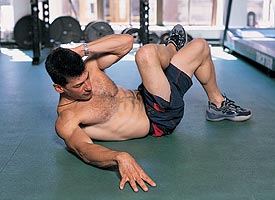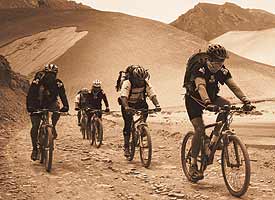“Humans are animals,” says Cathy Sassin, 38, owner of a Los Angeles nutrition consulting firm who has competed in nearly two dozen adventure races and placed first in the 1999 and 2000 Elf Authentic ���ϳԹ���. “The more time we spend staring at screens and jabbing at keyboards, the more our animal instincts cry out to do something wild and extreme.” Along with Sassin, plenty of others are freeing their cubicle-confined inner wildcat by joining the planet’s hottest multisport trend.
In recent years, adventure racing—single-day to weeklong competitions in which teams hike, bike, rappel, paddle, and navigate through wilderness—has grown from a cult sport confined to the Raid Gauloises and the Eco-Challenge to a mainstream activity with hundreds of events worldwide. According to the United States ���ϳԹ��� Racing Association, an estimated 350 races will take place in North America in 2001, from the Endorphin FIX in West Virginia to the Cal-Eco ���ϳԹ��� Series in California, up from just two events in 1995. In those six years, the number of participants has grown from 400 to some 10,000. Armchair adventure-racing is on the rise, too; the USA Network’s ratings for this year’s Eco-Challenge doubled compared to the broadcast last year. Survivor-mania plays a role too. Wipe that grin off your face, Mark Burnett.
Why the adventure-racing boom? Competitors say that training for a race offers a nice departure from the typical endurance-sports formula: There’s no asphalt, no stopwatch, and never the same activity twice in a row. “I think of what I do more as a lifestyle than a training program,” says pro racer Robyn Benincasa.
Fortunately, adventure races no longer require weeks of sleep-deprived, leptospire-infested competition in the Borneo jungle or the Australian rainforest, thanks to a plenitude of homegrown one- and two-day events (compared to the six- to 12-day races like the Eco-Challenge). Hence the following primer, dishing on everything from choosing a race to choosing your socks. Read on, round up your teammates, and begin your training. After all, you really are an animal. Isn’t it time you started acting like one?
Prep Talk
A successful adventure race begins long before the starting gun sounds
Choosing a Race: Event reviews are traded frequently among participants in the adventure- racing e-mail list maintained by champion racer Robert Nagle; subscribe at www.adventurerac ing.org. For a complete calendar of North American adventure races, visit the USARA Web site at www.usara.com. Consider, too, that the “adventure racing” moniker gets attached to events of many different shapes and sizes. The popular Hi-Tec ���ϳԹ��� Racing Series events consume three to five hours and involve no navigation (they’re in suburban settings), while events like the Endorphin FIX span a couple of days in the rural environs of West Virginia’s New River Gorge. Need a few more suggestions? See “You’ll Never Forget…,” facing page.
Picking a Team: The most common adventure-racing team format is a coed foursome, but most events now include multiple categories and welcome single-sex teams and teams as small as two members. How to recruit? “The most important quality any teammate can have is a good attitude that doesn’t wither under stress,” says Don Mann, author of The Complete Guide to ���ϳԹ��� Racing, published in April (Hatherleigh Press, $20). Also, sign up teammates whose fitness levels are comparable to your own and whose skills complement yours. You’re a strong biker? Ring up your expert-paddler friend.
Choosing a Support Crew: Many weekend adventure races allow support teams—usually in the form of dear, devoted friends (one to four, depending on the race). This crew is responsible for having their team’s equipment ready at each official checkpoint. Generally, they also feed the racers a quick, hot meal, perform light first aid, and pass on useful information (weather conditions, water levels, the team’s position, etc.). “Look for organization, a good disposition, and technical knowledge, in that order,” says Nagle.
Skills: The core adventure-racing skills are land and water navigation, packing and carrying a backpack, basic rope work (usually rappelling on a fixed line or sliding along a Tyrolean traverse), and bike maintenance. “Ideally, the members of your team will have a mix of skills, so you can teach them to each other,” says Nagle. “But if none of you knows any navigation, for example, it would be a good idea to go get that training as a team.”
Conditioning: “The first thing you need to do is sit down and figure out how much time you can spend training for this sport on a weekly basis,” says Don Mann. “If you have at least six hours a week to train, you can complete a 24- or 48-hour race.” Mann, 43, divides training into two components: conditioning and skills. Conditioning should absorb about 90 percent of your time; skills, the rest. By race day, you’ll need marathon-level endurance, i.e. you should be able to run, mountain bike, or paddle at a fairly intense level for at least three hours. If possible, plan for four months of consistent, incremental training (maybe half this amount of time if you already have a solid endurance base). No need to be anal—heart-rate monitors are optional—just be steady, dividing your time fairly evenly among running, mountain biking, and paddling, with extra time spent on your weakest event. Periodically, go hard; periodically, go long.
If you’ve got eight hours a week to train and you’re a terrible paddler, your regimen should look something like this:
Monday: off. Tuesday: one-hour mountain-bike ride. Wednesday: one hour of kayaking. Thursday: one-hour trail run with pack. Friday: one-hour nighttime mountain-bike ride with pack. Saturday: two hours of kayaking with team. Sunday: two-hour orienteering race with team.
Finishing School
Okay, you’ve got the endurance to go the distance. But that’s only part of the adventure-racing game. Here’s what else you need to know.
Navigation: Most weekend adventure races involve map-and-compass-type navigation, with teams “connecting the dots” from checkpoint to checkpoint, the locations of which are typically revealed just before the race begins. “Study your map well before plotting your course,” counsels Nagle. Establish your route before you begin moving, and make sure everyone’s map-and-compass skills are well rehearsed (GPS receivers are to adventure racing what steroids are to track and field). Learn to judge distance traveled by pacing, a critical strategy when traveling at night. Lost? Plot a course toward a landmark that’s easily intersected, like a river or trail. Follow other teams only as a last resort.
Team Management: Once on the course, says Sassin, “80 percent of success in adventure racing comes from team dynamics.” The golden rules of communication, as your girlfriend, boyfriend, spouse, or marriage counselor will tell you, are to refrain from assigning blame and making negative comments—and to ask for help from your partners when you need it. Remember: Democracy works. All team members should participate actively in decision making and problem solving, and the major- ity should rule.
Pacing: Forget clocking minutes per mile or miles per hour (or, in some cases, hours per mile). The key principle of pacing during an adventure race is this: “Your team will travel fastest when every member is using the same amount of energy all the time,” says Sassin. Put the most weight on who ever is strongest in the present discipline or is feeling best at the time. Also, place your slowest teammate near the front; it’s good for morale and ensures that the team doesn’t travel too fast. Relieve struggling teammates of weight and—when things get really bad—tow your faltering racer.
Nutrition: ���ϳԹ��� racing burns as many as 20,000 calories during a 48-hour race (Nagle lost 22 pounds during his eight-day first-place effort in the ’98 Raid). Expect to eat something every hour, even if you feel full or miserable or, commonly, both. Carry just enough to get you to the next supported checkpoint, where you can grab something hot and go. Many racers prefer snacks like beef jerky and Gummi Bears over trail mix and energy bars. “The four adventure-racing food groups are sugar, salt, fat, and caffeine,” says Eco-Challenge vet Robyn Benincasa. As for fluids, check your pee; it should be as clear as Sprite during the race. More like Mountain Dew? High time to hydrate. Swig a few ounces of an electrolyte drink every ten minutes and down juice and caffeinated beverages (flat Coke is a favorite) at checkpoints.
Equipment: The two most common gear mistakes made by novice racers are choosing luxury (overbuilt backpacks, full-suspension bikes) over economy, thus carrying unnecessary gear (more than one sawed-off toothbrush for the team). Weight is the enemy; carry one item for multiple uses: Your bra is also two pockets. Duct tape repairs everything. Bring all items on a race’s required equipment list—but little else (some essentials that may not make the list: trekking poles to take stress off feet and knees, bungee cords for towing knackered teammates). Be sure to train at least once with every piece of clothing and equipment you plan to use during the race. And a tip from the pros: Wear thin socks (two pairs if it’s overly chilly); they’ll help prevent blisters.
You’ll Never Forget Your First Time
Top event picks for adventure-racing rookies
September 8-9
Raid the North
Trekking, mountain biking, canoeing, rappelling, rafting; 93 miles
Elliot Lake, Ontario, Canada, 877-846-8889;
www.raidthenorth.com
September 28-30
Endorphin FIX
Mountain biking, trekking, paddling, swimming; 100 miles
New River Gorge, West Virginia, 757-425-2445;
www.oarevents.com
September 29-30
AT&T Wireless Kokopelli ���ϳԹ��� Race
Trail running, canoeing, mountain biking; 100 miles
Grand Junction, Colorado, 303-635-2815;
www.emgcolorado.com
November 3-4
Mountain Rage
Mountain biking, rappelling, swimming, orienteering, kayaking; 110 miles Lake Mead, Nevada, 800-775-7671;
www.4windsadventure.com
November 15-16
USARA 24-Hour ���ϳԹ��� Race
Trail running, canoeing, mountain biking, rappelling; 100 miles n Leesville, California, 713-532-5572;
www.mesp.com
Hard to the Core
Add an oblique twist to your resistance-training workout, courtesy of world-class paddler Eric Jackson

Washboard abs are nice, but they’re nothing next to washboard obs. Those would be your obliques—twin sets of muscles that wrap around your sides and help execute twisting motions. Take note, paddlers, surfers, mountain bikers, climbers, and aspiring living-room Twister champions: Obliques training should be an integral (not optional, not occasional) part of any conditioning program. “Nobody hurts himself toward the end of the season when obliques are honed,” says Eric Jackson, 37, winner of this year’s national freestyle kayak championships. “It’s always at the beginning of the season, when you haven’t been working them.” For world-class obs, add the following exercises—Jackson’s favorite methods of self-torture—to the end of any resistance-training workout. You’ll soon possess a midriff that does more than just look good in a mirror. —Michelle Pentz
Table Twist
Lie flat on your back. Extend both arms above your head and grasp heavy table legs or something similarly immobile. Raise both legs slowly until they are perpendicular to the floor. Keeping your legs straight, drop your feet to one side until they almost touch the floor; then raise them back up and drop to the other side. Start with: three sets of 30. No problem? Attempt Jackson’s three sets of 75 a day. Still feeling burly? Cut reps to 30 but add five-pound ankle weights.
O Crunch
Lie on your back with your knees bent, your left foot on the floor, and your right ankle resting on your left knee. Keep your right arm out to the side and the left arm folded behind your head. With both hips on the floor, rotate your left shoulder toward your right knee and roll up as in a regular crunch (not a full sit-up). Repeat with the other side. Start with: three sets of 15. No problem? Try three sets of 30. Still feeling burly? Do them on a Swiss ball.
Wood Chopper
Attach a Sport Cord (rubber tubing with handles) or heavy-gauge surgical tubing to a fixed anchor at shoulder height, or grasp a rope handle hooked to weight stacks. With hips forward, hold tubing or rope behind you with both hands. With your arms bent slightly, bring your hands over your head in an arc down to the outside of your left knee. Keep your hips steady. Repeat on the opposite side. Start with: three sets of ten. No problem? Do three sets of 30. Still feeling burly? Do them one-handed.
Torso Swivel (not shown)
Say hello to your new best friend: your gym’s rotary torso machine. Secure your legs and bear-hug the part of the machine that moves. Start with less weight than you may think you need; the key is lots of reps, Jackson says. Rotate your torso from center to right, then center to left. Start with: three sets of ten, with enough weight to exhaust you at the end of each set. No problem? Add three more reps to each set. Still feeling burly? Follow immediately with a set of Swiss-ball crunches described above.


